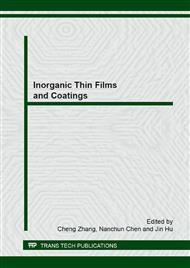[1]
L. Zhuang, X. Q. Xu, H. Shen, A study on the gasochromic properties of WO3 thin films, Surface and Coatings Technology. 167(2000) 217-220
DOI: 10.1016/s0257-8972(02)00904-0
Google Scholar
[2]
C. G. Granqvist, Electrochromic tungsten oxide films: Review of progress 1993–1998, Solar Energy Materials and Solar Cells. 60 (2000) 201-262
DOI: 10.1016/s0927-0248(99)00088-4
Google Scholar
[3]
J. L. Solis, S. Saukko, L. Kish, Semiconductor gas sensors based on nanostructured tungsten oxide, Thin Solid Films. 391 (2) (2001) 255-260
DOI: 10.1016/s0040-6090(01)00991-9
Google Scholar
[4]
A. Geog, W. Graf, R. Neumann, Stability of gasochromic WO3 films, Solar Energy Materials and Solar Cells. 63 (2000) 165-176
DOI: 10.1016/s0927-0248(00)00006-4
Google Scholar
[5]
S. K. Deb, Electrochromism in tungsten oxide film, Appl. Opt. 58(1969) 190-196
Google Scholar
[6]
V. Wittwer, M. Datz, I. Ell, Gasochromic windows, Solar Energy Mater Solar Cells. 84 (2004) 305
DOI: 10.1016/j.solmat.2004.01.040
Google Scholar
[7]
C. G. Granqvist, Transparent conductors as solar energy materials: A panoramic review, Solar Energy Mater Solar Cells. 91(17) (2007) 1529
DOI: 10.1016/j.solmat.2007.04.031
Google Scholar
[8]
R. B. Goldner, R. D. Rauh, Electrochromic materials for controlled radiant energy transfer in buildings, Solar Energy Mater. 11(3) (1984) 177
DOI: 10.1016/0165-1633(84)90069-8
Google Scholar
[9]
A. Georg, W. Graf, R. Neumann, Mechanism of the gasochromic coloration of porous WO3 films, Solid State Ionics. 127 (2000) 319-328
DOI: 10.1016/s0167-2738(99)00273-8
Google Scholar
[10]
J. Z. Ou, M. H. Yaacob, In situ Raman spectroscopy of H2 interaction with WO3 films, Phys. Chem. Chem. Phys. 13(2011) 7330-7339
DOI: 10.1039/c0cp02050h
Google Scholar
[11]
N. Sharma, M. Deepa, FTIR and absorption edge studies on tungsten oxide based precursor materials synthesized by sol–gel technique, Journal of Non-Crystalline Solids. 306 (2002) 129-137
DOI: 10.1016/s0022-3093(02)01134-1
Google Scholar
[12]
U. O. Krasovec, B. Orel, A. Georg, The gasochromic properties of sol–gel WO3 films with sputtered Pt catalyst, Solar Energy. 68 (6) (2000) 541-551
DOI: 10.1016/s0038-092x(00)00033-5
Google Scholar
[13]
N. Ozer, C. M. Lampert, Electrochromic performance of sol-gel deposited WO3–V2O5 films, Thin Solid Films. 349 (1/2) (1999) 205-211
DOI: 10.1016/s0040-6090(99)00144-3
Google Scholar
[14]
B.H. Loo, J.N. Yao, H.D. Coble, A Raman microprobe study of the electrochromic and photochromic thin films of molybdenum trioxide and tungsten trioxide, Appl. Surf. Sci. 81(1994) 175-181
DOI: 10.1016/0169-4332(94)00150-2
Google Scholar
[15]
K. Nishio, T. Sei, T. Tsuchiya, Preparation of electrochromic tungsten oxide thin film by sol-gel process, Journal of the Ceramic Society of Japan. 107 (3) (1999) 199-205
DOI: 10.2109/jcersj.107.199
Google Scholar


